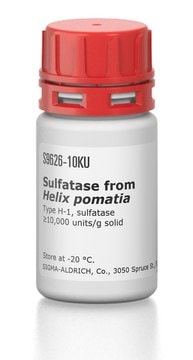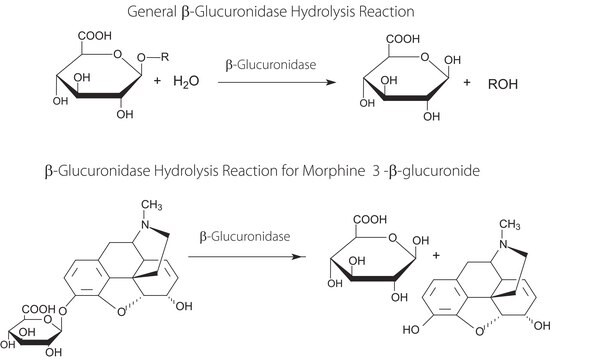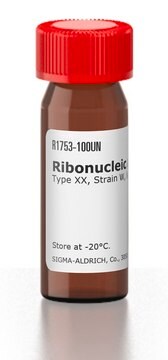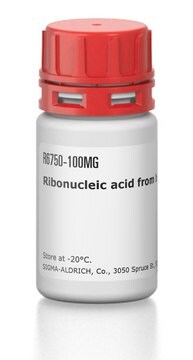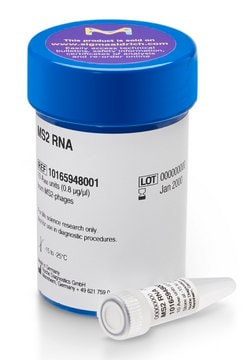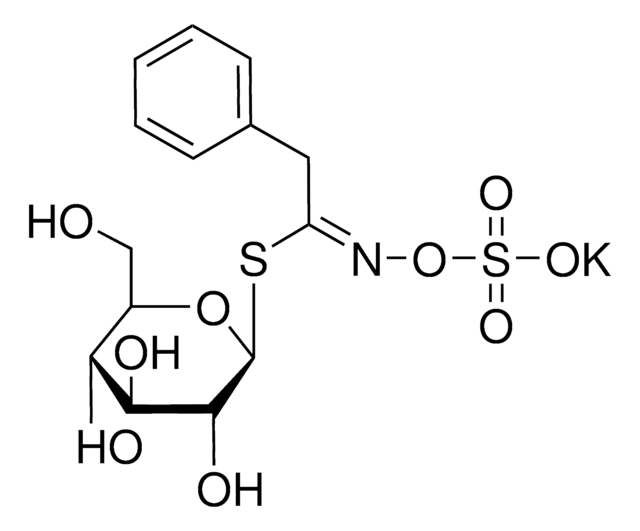S9751
Sulfatase from Helix pomatia
Type H-2, aqueous solution, ≥2,000 units/mL
Synonym(s):
Aryl-sulfatase, Aryl-sulfate sulfohydrolase, Phenolsulfatase
Sign Into View Organizational & Contract Pricing
All Photos(1)
About This Item
CAS Number:
MDL number:
UNSPSC Code:
12352204
NACRES:
NA.54
Recommended Products
type
Type H-2
Quality Level
form
aqueous solution
secondary activity
≥100,000 units/mL β-glucuronidase (at pH 5.0)
mol wt
~85 kDa by gel filtration
concentration
≥2,000 units/mL
shipped in
wet ice
storage temp.
2-8°C
Looking for similar products? Visit Product Comparison Guide
General description
Sequential action of sulfatase from Helix pomatia and β-O-glucosidase from Caldicellulosiruptor saccharolyticus on glucosinolates allows synthesis of thiohydroximates. Sulfatase from Helix pomatia hydrolyzes β-naphthyl sulfate much faster than α-naphthyl sulfate.
Application
Sulfatase from Helix pomatia is often used to remove sulfate groups from carbohydrates.
Unit Definition
One unit will hydrolyze 1.0 μmole of p-nitrocatechol sulfate per hour at pH 5.0 at 37 °C (30 min assay).
substrate
Product No.
Description
Pricing
Signal Word
Danger
Hazard Statements
Precautionary Statements
Hazard Classifications
Resp. Sens. 1 - Skin Sens. 1
Storage Class Code
12 - Non Combustible Liquids
WGK
WGK 2
Flash Point(F)
Not applicable
Flash Point(C)
Not applicable
Choose from one of the most recent versions:
Already Own This Product?
Find documentation for the products that you have recently purchased in the Document Library.
Customers Also Viewed
Jakub Kopycki et al.
Biotechnology letters, 33(5), 1039-1046 (2011-01-27)
Thiohydroximates comprise a diverse class of compounds important in both biological and industrial chemistry. Their syntheses are generally limited to simple alkyl and aryl compounds with few stereocenters and a narrow range of functional groups. We hypothesized that sequential action
Abigail M Tokheim et al.
Biometals : an international journal on the role of metal ions in biology, biochemistry, and medicine, 18(5), 537-540 (2005-12-08)
Often used to remove sulfate groups from carbohydrates, the regulatory properties of the aryl sulfatase from Helix pomatia remain little characterized. As many hydrolytic enzymes utilize exogenous metal ions in catalysis, the effect of various divalent metal ions on the
G Pelsy et al.
Biotechnology and bioengineering, 25(4), 919-928 (1983-04-01)
It has been found that sulfatase from Helix pomatia hydrolyzes beta-naphthyl sulfate much faster than alpha-naphthyl sulfate; e.g., at pH 7.8, while the former is readily hydrolyzed, the latter undergoes no appreciable hydrolysis. Kinetic investigations of both enzymatic and acid
Kenneth Dr Setchell et al.
The American journal of clinical nutrition, 90(4), 1029-1037 (2009-08-28)
The nonsteroidal estrogen equol occurs as diastereoisomers, S-(-)equol and R-(+)equol, both of which have significant biological actions. S-(-)equol, the naturally occurring enantiomer produced by 20-30% of adults consuming soy foods, has selective affinity for estrogen receptor-beta, whereas both enantiomers modulate
Tania Merinas-Amo et al.
Foods (Basel, Switzerland), 10(11) (2021-11-28)
Brassica rapa L. subsp. rapa (turnip greens), a traditionally consumed vegetable, is well-known due to its high content of glucosinolates, which are secondary metabolites with a positive biological activity for human health. Our hypothesis has been based on the relation
Protocols
Enzymatic Assay of Sulfatase (EC 3.1.6.1.)
Our team of scientists has experience in all areas of research including Life Science, Material Science, Chemical Synthesis, Chromatography, Analytical and many others.
Contact Technical Service

